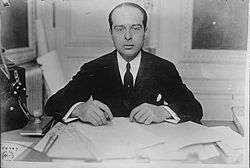Leland B. Harrison

Leland B. Harrison (25 April 1883, in New York City – 6 June 1951, in Washington D.C.), was a United States diplomat. The son of W. Henry Harrison and Helen (Skidmore) Harrison.
He was educated at Eton College, Harvard College, and Harvard Law School. After law school, Harrison became the private secretary of United States Ambassador to Japan Thomas J. O'Brien. He was appointed Third Secretary of the U.S. Embassy in Tokyo on June 10, 1908. He later filled posts in the United States embassies in Peking, London, and Bogotá. In 1918, he became diplomatic secretary of the American Commission to Negotiate Peace. He later became counselor of the U.S. Embassy in Paris.
In 1916 President Woodrow Wilson allowed Secretary of State Robert Lansing and Frank Polk quietly and informally to channel the flow of military and law enforcement material into the State Department's Bureau of Secret Intelligence (U-1), what is now known as the Diplomatic Security Service. The two men picked Leland Harrison "to take charge of the collection and examination of all information of a secret nature coming into the Department from various sources and also to direct the work of the agents specially employed for that purpose." [1][2]
In 1921, Harrison moved to Washington, D.C. to become assistant to the Conference on the Limitation on Armament. On March 21, 1922, Harrison was named United States Assistant Secretary of State and he held this office from March 31, 1922 to June 30, 1924.
He married Anne C. Coleman on June 27, 1925.
In 1927, Harrison was named Minister to Sweden, a post he held from May 31, 1927 to November 11, 1929. He also headed the U.S. delegation to the International Telegraph Conference in Brussels in 1928. In 1929, he became Minister to Uruguay, holding this post from April 11, 1930 to October 9, 1930. He then resigned temporarily from the United States Foreign Service. A short time later, however, he returned to government service as chief of the International Relations Division of the United States Tariff Commission. On May 15, 1935, he was named Minister to Romania, serving there from July 24, 1935 to September 3, 1937. He was then Minister to Switzerland from September 10, 1937 to October 14, 1947. Harrison retired on February 29, 1948. After his death in 1951, he was buried in the cemetery of the Church of St. James the Less in Philadelphia.
References
| Wikimedia Commons has media related to Leland B. Harrison. |
- Political Graveyard file
- "Leland Harrison, Ex-Diplomat, Dies," New York Times, June 7, 1951
| Government offices | ||
|---|---|---|
| Preceded by Fred Morris Dearing |
United States Assistant Secretary of State March 31, 1922 – June 30, 1924 |
Succeeded by Office abolished |
| Diplomatic posts | ||
| Preceded by Robert Woods Bliss |
United States Ambassador to Sweden May 31, 1927 – November 11, 1929 |
Succeeded by John Motley Morehead III |
| Preceded by Ulysses Grant-Smith |
United States Ambassador to Uruguay April 11, 1930 – October 9, 1930 |
Succeeded by J. Butler Wright |
| Preceded by Alvin M. Owsley |
United States Ambassador to Romania July 24, 1935 – September 3, 1937 |
Succeeded by Franklin Mott Gunther |
| Preceded by Hugh R. Wilson |
United States Ambassador to Switzerland and Liechtenstein September 10, 1937 – October 14, 1947 |
Succeeded by John Carter Vincent |